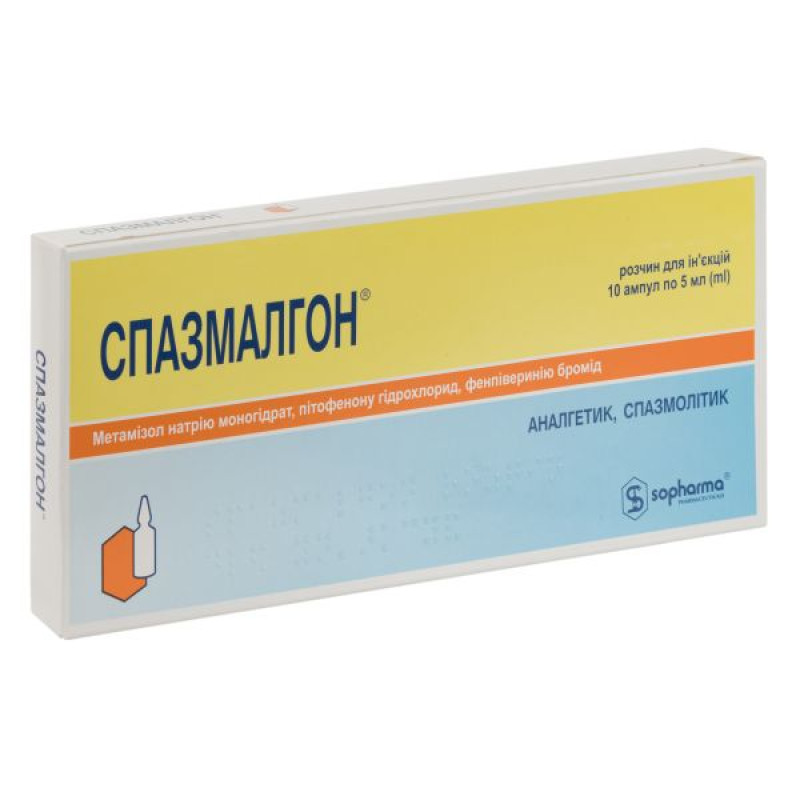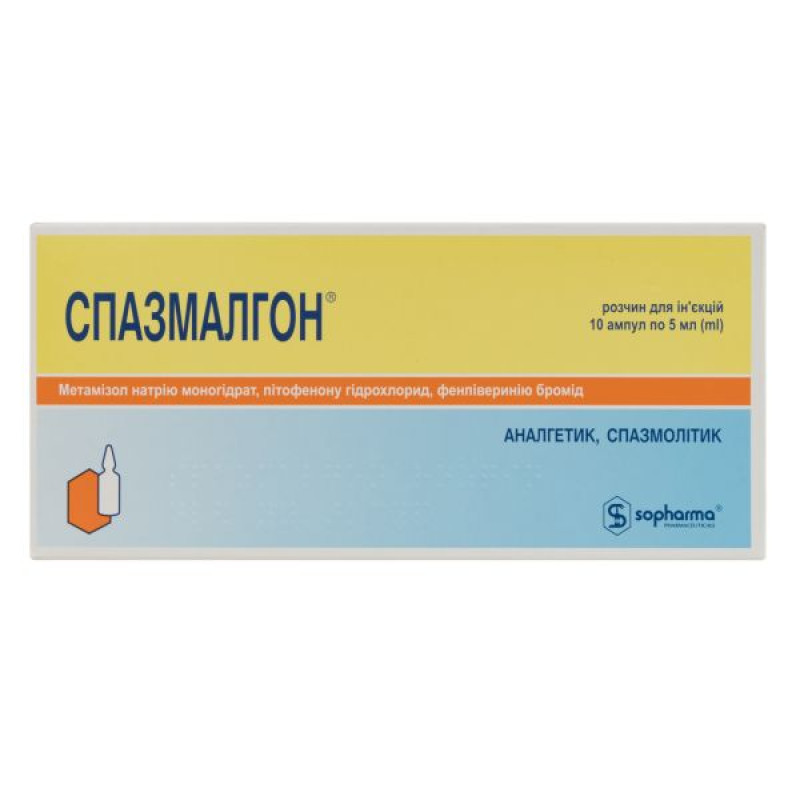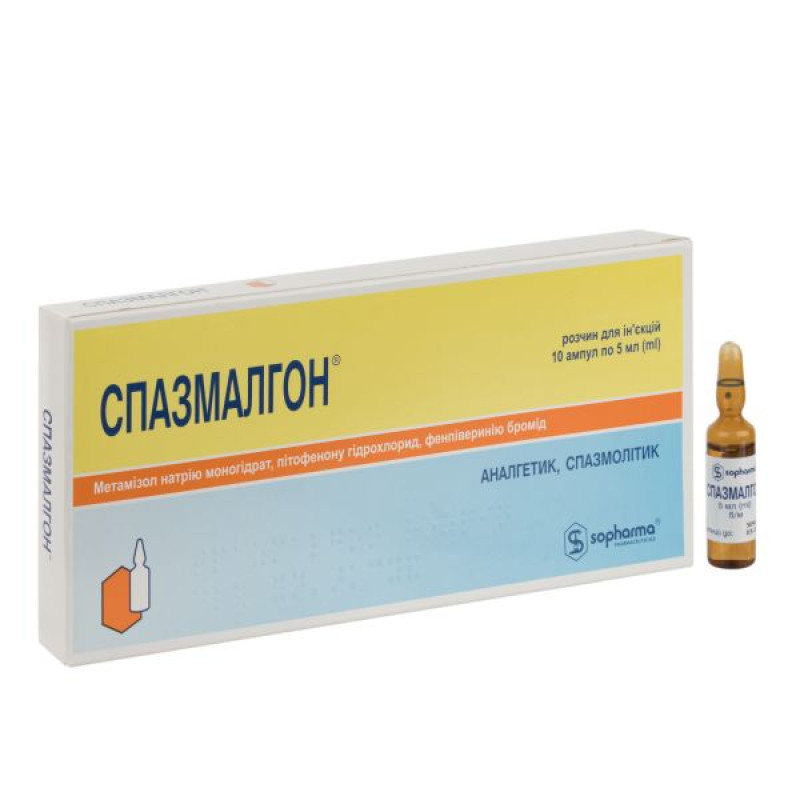Spazmalgon solution for injection ampoule 5 ml No. 10

Instructions Spazmalgon solution for injection ampoule 5 ml No. 10
Composition
active ingredients: metamizole sodium monohydrate, pitophenone hydrochloride, fenpiverinium bromide;
1 ml of solution for injection contains: metamizole sodium monohydrate 500 mg; pitofenone hydrochloride 2 mg; fenpiverinium bromide 0.02 mg;
excipients: water for injections.
Dosage form
Solution for injection.
Main physicochemical properties: clear liquid, almost free of particles.
Pharmacotherapeutic group
Antispasmodics in combination with analgesics. ATX code A03D A02.
Pharmacological properties
Pharmacodynamics
Spazmalgon® is a combined drug with pronounced antispasmodic and analgesic activity.
Metamizole has a pronounced analgesic and antipyretic effect in combination with weaker anti-inflammatory and antispasmodic activity. The result of its action is the inhibition of the synthesis of prostaglandins and endogenous algogens, an increase in the threshold of excitability in the thalamus, an effect on the hypothalamus and the formation of endogenous pyrogens.
Fenpiverinium has a moderately pronounced ganglioblocking and anticholinergic effect. It suppresses the tone and motility of the smooth muscles of the stomach, intestines, biliary and urinary tracts.
Pitofenone hydrochloride has a papaverine-like effect with pronounced antispasmodic activity against smooth muscles.
Pharmacokinetics
Absorption: Rapidly absorbed after intramuscular administration. Metamizole has a systemic bioavailability of approximately 85%.
Distribution: Metamizole is 50-60% bound to plasma proteins. Penetrates the blood-brain and placental barriers. The volume of distribution is approximately 0.7 l/kg.
Metabolism: Metamizole undergoes extensive biotransformation in the liver. Its main metabolite 4-methyl-amino-antipyrine (MAA) is metabolized in the liver to form other metabolites, including 4-amino-antipyrine (AA), which is pharmacologically active. Maximum plasma concentrations (relative to all metabolites) are achieved after approximately 30-90 minutes.
Excretion: Excreted by the kidneys in the form of metabolites, with only 3% of the excreted amount of metamizole excreted unchanged. The half-life is approximately 10 hours.
Patients with impaired liver function: the half-life of the active metabolite MAA is prolonged approximately 3-fold in patients with impaired liver function. Treatment with lower doses of metamizole is recommended in such patients.
Patients with renal impairment: In patients with renal impairment, the excretion of some metabolites is reduced. In such patients, treatment with lower doses of metamizole is recommended.
Indication
For short-term symptomatic treatment of pain syndrome in spasms of smooth muscles of internal organs:
gastric and intestinal colic; renal colic in nephrolithiasis; spastic dyskinesia of the biliary tract; dysmenorrhea.
Contraindication
Hypersensitivity to the active substances, to pyrazolone derivatives (including in patients with a history of agranulocytosis with previous use of similar drugs) or to other non-steroidal anti-inflammatory drugs (NSAIDs).
Severe liver and kidney dysfunction.
Acute hepatic porphyria.
Glucose-6-phosphate dehydrogenase deficiency.
Gastrointestinal obstruction and megacolon.
Impaired bone marrow function (e.g. after treatment with cytostatics).
Diseases of the hematopoietic system (agranulocytosis, leukopenia, anemia of any etiology, including aplastic anemia, infectious neutropenia).
Prostate adenoma of II and III degree.
Atony of the gallbladder and urinary bladder.
Suspicion of surgical pathology.
Hypotonic conditions and hemodynamic instability.
Collaptoid states.
Tachyarrhythmia.
Angle-closure glaucoma.
Bronchial asthma.
Interaction with other medicinal products and other types of interactions
Combining Spazmalgon® with other medications requires special caution due to the content of metamizole, which is an inducer of liver enzymes.
When using the drug, alcohol consumption should be avoided, as there is a possibility of mutual potentiation of the effect.
Coumarin anticoagulants. When used simultaneously, metamizole may reduce the activity of coumarin anticoagulants as a result of induction of hepatic enzymes.
Chlorpromazine and other phenothiazine derivatives: When used simultaneously with metamizole, there is a risk of severe hypothermia.
Cyclosporine: Metamizole reduces the plasma levels of cyclosporine when used simultaneously.
Chloramphenicol and other myelotoxic agents: When used simultaneously with metamizole, there is an increased risk of bone marrow suppression.
Enzyme inducers (barbiturates, glutethimide, phenylbutazone) may weaken the effect of metamizole.
Metamizole significantly increases the maximum plasma concentrations of chloroquine.
Tricyclic antidepressants (psychophorine, amitriptyline), oral contraceptives, analgesics, allopurinol and alcohol slow down the metabolism of metamizole, potentiate its effect when used simultaneously and increase its toxicity.
Concomitant use with other analgesics and NSAIDs increases the risk of hypersensitivity reactions and other adverse reactions.
Sedatives and tranquilizers enhance the analgesic effect of the drug.
When using Spazmalgon® simultaneously with quinine preparations, the anticholinergic effect may be enhanced.
Spasmalgon® can be combined with hyoscine butylbromide, furosemide, and glibenclamide.
The pyrazolone class of derivatives is known to interact with captopril, lithium, methotrexate, and triamterene, and to alter the efficacy of antihypertensives and diuretics. The extent to which metamizole causes these interactions is unknown.
Since metamizole may reduce the effect of certain drugs, Spazmalgon® should be used with caution with the following drugs:
bupropion – used to treat depression or as an aid to stop smoking; efavirenz – used to treat HIV/AIDS; methadone – used to treat addiction to illicit substances (so-called opioids); valproate – used to treat epilepsy or bipolar disorder; tacrolimus – used to prevent organ rejection in transplant patients; sertraline – used to treat depression.
Application features
When treating with Spazmalgon®, there is a risk of developing anaphylactic reactions. At the first signs of hypersensitivity, the administration of the drug should be stopped immediately and urgent measures should be taken to relieve the condition (adrenaline, glucocorticoids, antihistamines).
The risk of hypersensitivity reactions (anaphylactoid reactions) when using metamizole is significantly increased in patients with:
food and drug hypersensitivity or atopic diseases (hay fever); analgesic asthma syndrome or analgesic idiosyncrasy in the form of urticaria, angioedema, especially with concomitant rhinosinusitis and nasal polyps; chronic urticaria; idiosyncrasy to dyes (e.g. tartrazine) or preservatives (e.g. benzoates); alcohol intolerance. Such patients react to the use of minimal amounts of alcoholic beverages with symptoms such as sneezing, tearing and severe visual impairment. Such alcohol intolerance may be a sign of undiagnosed analgesic asthma syndrome.
Spazmalgon® contains the drug metamizole, which carries a small but life-threatening risk of shock and agranulocytosis. The development of agranulocytosis is dose-dependent and unpredictable. It may occur after the first dose or after repeated administration. Typical signs of agranulocytosis are fever, sore throat, pain when swallowing, inflammation of the mucous membranes of the mouth, nose, pharynx, anorectal and genital areas. In case of sudden deterioration of the general condition and the appearance of signs of agranulocytosis, treatment with metamizole should be stopped immediately, without waiting for laboratory confirmation.
The drug should be used with caution in patients with chronic alcoholism; elderly patients, as this may lead to an increased incidence of adverse reactions, especially from the digestive system.
The drug should be used with caution in patients receiving concomitant cytostatic drugs (only under the supervision of a physician).
Do not use to relieve acute abdominal pain.
When treating patients with hematological diseases or who have a history of them with Spazmalgon®, it is necessary to assess the risk/benefit ratio and monitor the hematological status during treatment.
The drug should be used with caution in patients with impaired renal function and a history of kidney disease (pyelonephritis, glomerulonephritis).
In kidney and liver diseases, the dosage regimen should be selected individually due to possible side effects of metamizole on the kidneys and an increase in the half-life of metamizole metabolites in case of impaired hepatocyte function.
The drug should be used with caution in patients with obstructive diseases of the gastrointestinal tract (achalasia, pyloroduodenal stenosis). Repeated use of Spazmalgon® in these cases may cause delayed elimination of gastrointestinal contents and intoxication.
The use of Spazmalgon® in patients with gastroesophageal reflux disease, intestinal atony, inflammatory bowel diseases, including nonspecific ulcerative colitis and Crohn's disease, glaucoma, myasthenia gravis, and heart diseases (arrhythmias, ischemic heart disease, congestive heart failure) requires special caution and medical supervision.
Metamizole, which is included in the preparation Spazmalgon®, can cause hypotonic reactions. These reactions are dose-dependent and are more often observed with parenteral administration. The risk of such reactions increases in the following cases:
in patients with pre-existing hypotension, volume and electrolyte depletion or dehydration, unstable haemodynamics or circulatory failure (e.g. in patients with myocardial infarction or polytrauma); in patients with fever.
In such patients, careful assessment of the need for the drug and close monitoring should be carried out. It may be necessary to take precautionary measures (e.g., stabilization of the circulatory system) to reduce the risk of arterial hypotension.
Spazmalgon® should only be used with careful monitoring of hemodynamic parameters in patients in whom a decrease in blood pressure should be avoided as a matter of course, for example, severe ischemic heart disease or significant stenosis of cerebral vessels.
Liver inflammation has been observed in patients taking metamizole, with symptoms developing within a few days to several months after the start of treatment.
If the patient experiences symptoms that may indicate liver damage, such as nausea or vomiting, fever, fatigue, loss of appetite, dark urine, pale stools, yellowing of the skin or whites of the eyes, itching, rash, or upper abdominal pain, he should stop taking Spazmalgon® and consult a doctor. The doctor should evaluate the patient's liver function.
Spazmalgon® should not be used if the patient has previously experienced liver damage during treatment with metamizole.
Spasmalgon® should only be used after a strict benefit/risk assessment and appropriate precautions in patients with impaired renal or hepatic function.
Do not exceed the recommended doses of the drug.
Ability to influence reaction speed when driving vehicles or other mechanisms
The active substance fenpiverinium bromide has an anticholinergic effect and can cause dizziness and accommodation disorders. Metamizole can have an adverse effect on attention and impair reaction speed. Patients who drive vehicles or work with mechanisms should be warned about the possible side effects of the drug. Activities requiring increased attention should be stopped until the side effects disappear.
Use during pregnancy or breastfeeding
Pregnancy. The use of the drug during pregnancy is contraindicated due to the lack of clinical data.
Breastfeeding. Since metamizole metabolites are excreted in breast milk, the drug should not be administered during breastfeeding. If the use of the drug cannot be avoided, breastfeeding should be discontinued for a period of 48 hours after administration of the drug.
Method of administration and doses
Spasmalgon®, solution for injection, should only be used intramuscularly! Use only for short-term treatment!
The injection solution should be used under strict medical supervision due to the risk of anaphylactic shock in patients with hypersensitivity to metamizole or pyrazolone derivatives.
Adults and children aged 15 and over.
Adults and children over 15 years of age (with a body weight of more than 53 kg) should be administered intramuscularly from 2 to 5 ml of solution for injection. If necessary, repeat the dose after 6-8 hours. The maximum daily dose should not exceed 6 ml of solution for injection (equivalent to 3 g of metamizole sodium). Duration of treatment - 2-3 days. After achieving a therapeutic effect, you can switch to treatment with oral analgesics and antispasmodics. In the absence of a therapeutic effect, stop treatment with the drug.
Patients aged 65 and over.
Usually, no dose reduction is required. In patients with age-related liver and kidney dysfunction, the dose should be reduced, as the half-life of metamizole metabolites may be increased.
Patients with impaired renal function.
Metamizole is excreted in the urine as metabolites. In patients with mild to moderate renal impairment, ½ the adult dose is recommended.
Patients with liver dysfunction.
In these patients, the half-life of the active metabolites of metamizole is slowed down. In patients with impaired liver function, high doses should be avoided. With short-term use, there is no need to reduce the dose.
There is insufficient experience with long-term use in patients with impaired renal or hepatic function.
Children
The drug should not be used to treat children under 15 years of age.
Overdose
Symptoms: symptoms of metamizole intoxication in combination with cholinolytic manifestations prevail. Most often observed are toxic-allergic syndrome, hematotoxicity, gastrointestinal disorders, cerebral manifestations, including hypothermia, pronounced decrease in blood pressure, palpitations, shortness of breath, tinnitus, nausea, vomiting, gastralgia, weakness, oliguria, anuria, drowsiness, delirium, impaired consciousness, tachycardia, convulsive syndrome; development of acute agranulocytosis, hemorrhagic syndrome, acute renal and hepatic failure, paralysis of respiratory muscles.
Treatment: discontinue use of the drug and take measures for its rapid elimination from the body (forced diuresis, infusion of water-salt solutions, hemodialysis if necessary). Use symptomatic agents. There is no specific antidote.
Adverse reactions
The adverse reactions listed below are mainly caused by metamizole, which is a component of the medicinal product.
From the blood and lymphatic system: leukopenia, agranulocytosis, thrombocytopenia, anemia (hemolytic anemia, aplastic anemia).
The risk of agranulocytosis cannot be predicted. Agranulocytosis may also occur in patients who have used metamizole in the past without experiencing similar adverse reactions.
Immune system disorders: anaphylactic shock, anaphylactic or anaphylactoid reactions, especially after parenteral administration. Such reactions may occur during administration of the drug or immediately after discontinuation of the administration, but may also occur several hours later. They usually occur within the first hour after injection. Milder reactions manifest as typical skin and mucous membrane reactions (such as itching, burning, redness, urticaria, swelling - local or general), dyspnea and rarely gastrointestinal complaints. Mild reactions may progress to more severe forms with generalized urticaria, severe angioedema (including laryngeal), severe bronchospasm, cardiac arrhythmias, decreased blood pressure (sometimes with a previous increase in blood pressure).
For this reason, if any skin hypersensitivity reaction, symptoms of renal dysfunction or hematotoxic reactions occur, the drug should be discontinued immediately.
Asthma attack (in patients with analgesic asthma), circulatory shock. Shock may be accompanied by cold sweat, dizziness, drowsiness, changes in consciousness, pale skin, pressure in the heart area, shallow breathing or tachypnea, tachycardia, cold extremities, a sharp drop in blood pressure. At the first signs of shock, treatment should be discontinued and appropriate emergency measures taken.
Skin and subcutaneous tissue disorders: fixed drug exanthema, maculopapular and other types of rashes, Lyell's syndrome or Stevens-Johnson syndrome, angioedema, decreased sweating.
If any skin reaction occurs, the use of metamizole should be discontinued immediately.
From the nervous system: dizziness, headache.
From the sensory organs (vision): visual disturbances, accommodation disorders.
Cardiovascular system: palpitations, tachycardia, cardiac arrhythmias, cyanosis, hypotension, flushing. Hypotensive reactions may rarely occur during or after administration. They may or may not be accompanied by other symptoms of anaphylactoid or anaphylactic reactions. Rarely, such reactions may result from a sharp decrease in blood pressure. Rapid intravenous administration increases the risk of hypotensive reactions.
Critical decrease in blood pressure without other signs of hypersensitivity is dose-dependent and may manifest as hyperpyrexia.
Gastrointestinal: dry mouth, nausea, vomiting, abdominal pain and discomfort, constipation, exacerbation of gastritis and gastric ulcer, in rare cases, vomiting with blood and intestinal bleeding, ulceration, burning sensation in the epigastric region.
Liver and biliary tract: drug-induced liver damage, including acute hepatitis, jaundice, increased liver enzyme levels.
From the urinary system: proteinuria, oliguria, anuria, polyuria, interstitial nephritis, red urine color, urinary retention, difficulty urinating, impaired renal function.
Respiratory system: bronchospasm.
General disorders and administration site conditions: with parenteral use - asthenia, pain at the injection site and local reactions.
Expiration date
4 years.
Storage conditions
Keep out of reach of children.
Store in the original packaging at a temperature not exceeding 25 ° C. Do not freeze.
Packaging
5 ml of solution for injection in an ampoule. 10 ampoules in a blister. 1 blister in a cardboard pack.
Vacation category
According to the recipe.
Producer
JSC "Sopharma".
Location of the manufacturer and its business address
16 Ilienskoe Shose St., Sofia, 1220, Bulgaria.
There are no reviews for this product.
There are no reviews for this product, be the first to leave your review.
No questions about this product, be the first and ask your question.









